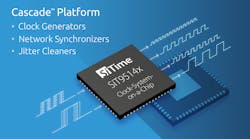SiTime unveiled the Cascade family of MEMS clock ICs for 5G, wireline telecom, and datacenter infrastructure applications. This clock-system-on-a-chip family, the SiT9514x, consists of clock generators, jitter cleaners, and network synchronizers to deliver multiple clock signals in a system. The clock family uses SiTime’s recently-launched third-generation MEMS resonators that deliver higher performance at lower power levels.
In contrast to legacy clock ICs with external quartz references, SiTime’s all-silicon clock architecture provides more integration, with a MEMS resonator reference inside the package. More importantly, the MEMS-based Cascade clock SoC delivers up to 10x higher reliability and resilience, reducing or eliminating downtime. Either standalone or together with SiTime’s MEMS TCXOs and OCXOs, the SiT9514x addresses applications such as 5G RRUs, small cells, edge computers, switches, and routers.
Features include an integrated MEMS resonator, which eliminates quartz issues such as capacitive mismatch, activity dips, and susceptibility to shock, vibration, and EMI. Four independent PLLs support time-synchronization applications where multiple independent clock domains are required, with up to 11 outputs at an operating frequency range from 8 kHz to 2.1 GHz, as well as a 1 PPS (pulse per second) output, for maximum frequency agility. Fail-safe operation in case of input-clock failures through faster hitless switching between four independent inputs, automatically switching to different input clock sources with minimum phase transient at the output. This allows the downstream PLL to remain locked, and the system to continue to operate reliably.
The devices are available with programmable features and configuration options such as blank ISP (in-system programmable) devices for maximum flexibility, and pre-programmed devices to enable system boot-up without software configuration for maximum simplicity . EVBs and TimeMaster software enable users to map clock configurations and generate the scripts for software integration, which speeds development.
